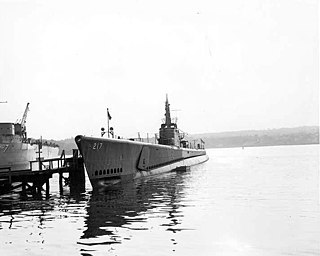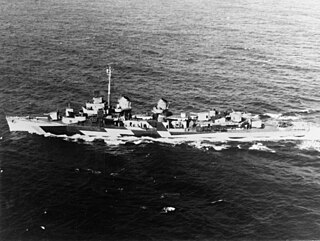
USS Mississinewa (AO-59) was the first of two United States Navy ships of the name. She was a T3-S2-A1 auxiliary oiler of the US Navy, laid down on 5 October 1943 by the Bethlehem Sparrows Point Shipyard, Inc., Sparrows Point, Maryland; launched on 28 March 1944; sponsored by Miss Margaret Pence; and commissioned on 18 May 1944. Mississinewa was commanded by Captain Philip G. Beck. The ship is named for the Mississinewa River of eastern Indiana.

USS Guardfish (SS-217), a Gato-class submarine, was the first ship of the United States Navy to be named for the guardfish.

USS Zuni (AT/ATF-95), a Cherokee-class fleet tugboat, formerly called Navajo class, was a ship of the United States Navy named for the Zuni, the popular name given to a tribe of Pueblo Indians indigenous to the area around the Zuni River in central New Mexico near the Arizona state line.

USS McGinty (DE-365) was a John C. Butler-class destroyer escort of the United States Navy.

USS Spence (DD-512), a Fletcher class destroyer, was laid down on 18 May 1942 by the Bath Iron Works, Bath, Maine; launched on 27 October 1942; sponsored by Mrs. Eben Learned; and commissioned on 8 January 1943. The ship was named for Robert T. Spence, superintendent of the construction of USS Ontario (1813), and captain of USS Cyane (1815).

USS Twiggs (DD-591), a Fletcher-class destroyer, was the second ship of the United States Navy to be named for Marine Major Levi Twiggs (1793–1847).

USS Melvin (DD-680), a Fletcher-class destroyer and the second ship of the United States Navy to be named for Lieutenant, junior grade John T. Melvin (1887–1917), who was killed on 5 November 1917 while serving on the USS Alcedo in World War I and is recognized as the first American naval officer to die in that war.

USS Dyson (DD-572) was a Fletcher-class destroyer of the United States Navy. She was named for Rear Admiral Charles W. Dyson (1861–1930).

USS McDermut (DD-677) was a Fletcher-class destroyer of the United States Navy, the second Navy ship named for Lieutenant Commander David A. McDermut.
USS Barite (IX-161), a Trefoil-class concrete barge designated an unclassified miscellaneous vessel, was the only ship of the United States Navy to be named for barite, a yellow or white crystalline mineral found in metallic veins, resembling marble. Her keel was laid down under a Maritime Commission contract on 24 November 1943 at South San Francisco, California, by the Belair Shipyard of Barrett and Hilp. She was designated IX-161 on 7 February 1944, launched on 18 February 1944 sponsored by Mrs. S. C. Anderson, and delivered to the Navy at her builder's yard on 31 August 1944. She was placed in service the same day.

USS Baham (AK-122/AG-71) was a Basilan-class auxiliary ship, converted from a Liberty ship, commissioned by the United States Navy for service in World War II. She was first named after former Florida, resident Elizabeth C. Bellamy, the daughter of General William Croom, and wife of Doctor Samuel C. Bellamy. According to legend she died on her wedding night when her dress caught fire, but she actually died three years after her wedding from malaria. She was renamed and commissioned after Baham, a star in constellation Pegasus. She was responsible for delivering troops, goods and equipment to locations in the war zone.

A Service Squadron (ServRon) was a United States Navy squadron that supported fleet combat ships and US Navy Auxiliary ships. Service Squadrons were used by the US Navy from their inception in 1943 to as late as the early 1980s. At the time of their inception during the Second World War they allowed the US Navy to operate across the vast reaches of the Pacific Ocean for extended periods of time. Service Squadrons created temporary forward bases to allow the naval squadrons to spend less time in transit and more time in the area of combat. Ulithi, a small volcanic atoll in the central Pacific, is an example of a site converted for use as a forward base of supply. Service Squadrons essentially created a major naval base near the area of operation. With naval bases like, Naval Base Ulithi, to refit, repair and resupply, many ships were able to deploy and operate in the western Pacific for a year or more without returning to a major port facility. Among the vessels operating in service squadrons were tankers, Fleet oilers, refrigerator ships, ammunition ships, supply ships, floating docks and repair ships. They provided diesel, ordnance, aviation fuel, food stuffs and all other supplies. Equally important at places like Ulithi were the portable piers and floating dry docks which allowed many ships damaged by enemy action or Pacific storms to undergo repair without having to travel the thousands of miles back to a major US naval base. Ulithi was as far forward from the US naval base at San Francisco as the San Francisco base was from London, England. To have a fully functional major port in the middle of the Pacific was a significant aid to U.S. Navy operations.

USS Richard S. Bull (DE-402) was a John C. Butler-class destroyer escort in service with the United States Navy from 1944 to 1946. She was finally sunk as a target in 1969.

USS Arctic (AF-7) was an Arctic-class stores ship acquired by the United States Navy shortly after World War I, which saw extensive service in World War II. She served in the Pacific Ocean, delivering food and household items to ships and bases.
USS Autauga (AK-160) was an Alamosa-class cargo ship commissioned by the US Navy for service in World War II. She was responsible for delivering troops, goods and equipment to locations in the war zone.
USS Gear (ARS-34) was a Diver-class rescue and salvage ship acquired by the U.S. Navy during World War II. Her task was to come to the aid of stricken vessels.
The first USS Keosanqua (AT-38) was launched 26 February 1920 by Staten Island Shipbuilding Company, Port Richmond, New York; and commissioned 9 December 1920 at New York Navy Yard.
USS Arapaho (AT-68/ATF-68) was a Navajo-class fleet ocean tug which served the U.S. Navy during World War II with her towing services. She was assigned initially to support the U.S. Atlantic Fleet, and was eventually assigned to support Allied forces in the war zones of the Pacific Ocean, resulting in her crew returning home after the war with four battle stars to their credit.

The second USS Wampanoag (ATA-202), originally USS ATA-202, is a United States Navy auxiliary ocean-going tug in commission from 1945 to 1947.

USS Avoyel (ATF-150) was an Navajo-class fleet tug built for the United States Navy during World War II. She was the only U.S. Naval vessel to bear the name.














